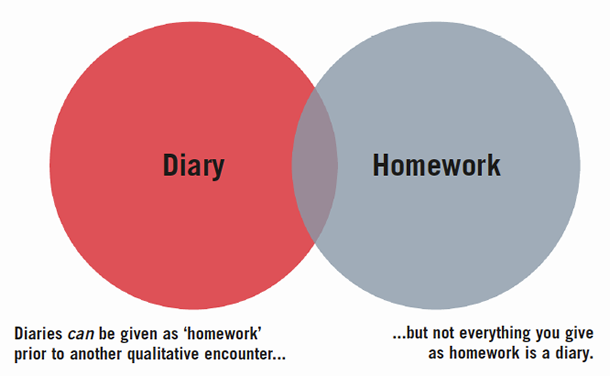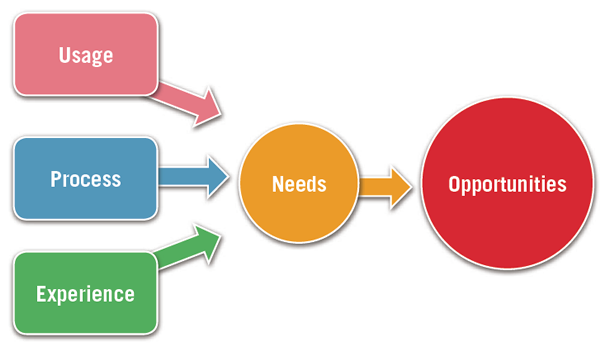During a recent study, I asked respondents about their snacking: when and why. You would have thought that these respondents were among the healthiest on the planet. Why, the apples they consumed could have denuded an entire orchard! Luckily, though, I had asked the respondents to keep a mobile diary of their snacking behavior for the week prior to the focus group. How quickly these respondents had forgotten the chips, Twinkies and, yes, even the Philly cheesesteaks that comprised their snacking behavior over the past week. The client received rich insights into aspiration vs. reality, and I had a lot of fun in the process.
Diary research can lead to deeper insights from your respondents. But creating a great diary assignment is more than just passing out blank paper and having respondents note every time they make a cup of coffee or use their online banking app.
What Is a Diary?
Diaries have three basic elements that, taken together, separate them from all other qualitative data:
- They are respondent generated.
- They capture a specific behavior, activity, experience or feeling.
- They happen over time.
Diaries can be given as homework (see Figure 1), but they do not have to be assigned prior to other research. They can work great as a standalone exercise or when assigned after an initial phase of research.

A Word about Nomenclature
In my work, I sometimes use the words “diary” and “journal” interchangeably. In his book Let’s Explore Diabetes with Owls, writer David Sedaris — himself a prolific diarist — noted, “Often, the terms are used interchangeably, though I’ve never understood why. Both have the word ‘day’ at their root but a journal, in my opinion, is a repository of ideas, your brain on the page. A diary, by contrast, is your heart.”
Indeed, there is something very personal conveyed by the term “diary,” which may be exactly what your study needs. If, however, you are asking school-age boys to keep some kind of diary, consider calling it a “journal” instead. I found from personal experience in my own house that “diaries” tend to elicit eye rolls in this demographic.
Why Use Diaries?
Diaries allow us to extend the amount of time that we spend with respondents. Furthermore, diaries allow us access to respondents at times when we might not want to be with them or when the researcher’s presence might compromise the respondent’s ability to be candid.
Diaries help researchers explore three broad types of question:
- Usage: Often, a marketer wants to know how the company’s product or service is actually being utilized in the real world, to identify problems or opportunities. Diaries kept over time allow respondents to capture their actual experiences with the client’s product in detail.
- Process: Diaries are great at reflecting consumers as they go through a particular experience, and they often provide deep insights about the purchase process. Consider asking your respondents to keep a diary when they buy a car, apply for college or go through chemotherapy and to note the expected and unexpected steps they take along the way.
- Experience: Sometimes, marketers have broader questions that they need to answer to help drive innovation or marketing messages. Experiential diaries help answer the question, ‘What is it like to…?”
Ultimately, diary studies are powerful for clients because they tend to lead to previously undiscovered consumer needs, which then point to opportunities for clients to innovate (See Figure 2).

Which medium Is best?
Believe it or not, paper can be a fabulous medium for the right type of diary study. Digital, of course, is rapidly expanding our ability to be with consumers 24/7, so it is important to think about what best fits your study.
Paper
Paper diaries provide a wealth of opportunity to ask respondents to think and work creatively. For example, a paper diary can allow respondents to write, draw and illustrate in ways they would struggle to do with a digital medium. A major drawback of paper diaries, however, is that you do not get to see what a respondent is working on in real time. If there is a problem with your instructions or if you wanted diary data to help drive discussion-guide development, you are out of luck.
Digital
More and more, the smartphone is becoming the digital-diary medium of choice; however, respondents can also participate in digital diaries using their PC or tablet. The pervasiveness of digital tools makes them particularly attractive for diary exercises: Since most of your respondents are probably carrying their mobile phones with them at all times, it makes good sense to ask them to use those devices to complete a diary exercise. That said, mobile technology tends to favor shorter, less introspective responses than one might get with, say, paper or a diary that uses a PC-based platform where respondents can type at length.
Table 1. Pros and Cons of Paper and Digital Diaries
| Type | Best for | Drawbacks |
| Paper Diaries | Smaller budgets
Creative assignments Low-tech respondents Easy access to diaries during follow-up research |
No research access during data collection
Hassle factor – printing, shipping, collecting, scanning, etc. |
| Digital Diaries | Capturing data at the time it is happening
Engaging clients Learning about respondents before they get in the room Pre-screening respondents for follow-up research |
Can feel sterile – need to work to create a warm environment
May not be a fit for all respondent types Cost not usually free |
Diary Exercises to Try
Ready to take your diary exercises to the next level? Below are a series of six activities to try that go beyond asking respondents to jot down every time they do X or purchase Y. All of the activities provide a basic structure, but they still leave room for you to customize and improve them to meet the needs of your next study.
What about platform?
A number of these exercises are best executed on a digital platform. The platform providers change all the time; for an up-to-the-minute guide, I would recommend checking out the New Qualitative Guide published by the Qualitative Research Consultants Association (QRCA) or, better yet, talking to QRCA colleagues who work with digital platforms regularly.
Although many of these exercises can be accomplished using free platforms, tools developed specifically for the marketing research industry make it really easy for moderator, client and respondent to participate in ways that are seamless and appropriate. Sometimes spending a few extra bucks on a paid platform is worth the investment in terms of your time and sanity.
Exercises
Timeline
Often, a diary seeks to capture a particular behavior over a time period that may vary by respondent. For example, a consumer in the market for a new car may research, shop and test drive for weeks before making a choice, or he may walk onto the lot and make a purchase rather quickly. The Timeline exercise is simple. Give each respondent a large piece of paper with an arrow drawn across it to represent time. Each time (s)he does something related to the activity of interest, (s)he notes it on the timeline. In this way, behaviors are captured as they happen but don’t need to follow a specified format.
Photo Album
We know consumers are already taking pictures of every aspect of their daily lives. Why not harness that for marketing re- search purposes? A photo-album diary exercise goes beyond having respondents take photos by asking them to organize those photos into a meaningful story with rich captions. And when the study is over, you can cherry-pick the best albums and use one of the many online tools to actually create hard-copy albums that the client team can use and refer to for months and years to come.
Moments
When we want to know about the emo- tions surrounding a particular behavior, the “moments” diary exercise is ideal. Consider the difference between “Take a photo of your morning coffee” and “Keep a journal of your coffee moments.” Ask respondents to tell you as much as they can about the moment — what was going on, how they felt and what made it a moment.
Easy & Hard
Often, clients want to capture product usage so that they can figure out what is working well and what is not. In these cases, consider structuring your diary exercise to capture what is easy and what is hard about using a particular product or service. In fact, this exercise works well with any polarity: How about yum/yuck, best/worst or fun/boring?
“Love is…”
Sometimes, it is important to understand how consumers think about a big attrib- ute such as love, clean or healthy. But getting them to articulate what these things mean can be tough. (How do you define clean?) A diary that asks respondents to capture photos that encapsulate a particular attribute can quickly get to higher-order benefits and provide agency or creative teams with a ton of fodder for creative development.
Deprivation Day
Deprivation day is not an exercise unto itself, but rather something to add on to a longer diary assignment. The way it works is this: If you are having respond- ents log some activity or product usage for a defined time period, ask them to spend a day going without that activity or product. For example, if respond- ents spend a week capturing “coffee moments,” ask them to go without coffee for a day and journal what hap- pens. What did they eat or drink or do instead? How did it feel? (You might call these “Non-coffee moments.”) A word of warning: Tell respondents dur- ing the recruit that you are going to ask them to do this; some might not be able to go without.
Final Words of Wisdom
Whether you are doing your 1st diary study or your 100th, you are never alone in the process. The technology providers all have relevant guides and case studies to spark your imagination, and I have found that many of them are willing to give you a free trial to get you started learning their platforms. After all, your success is their success! So, why not add a diary activity to your next project, and see what you can learn?
